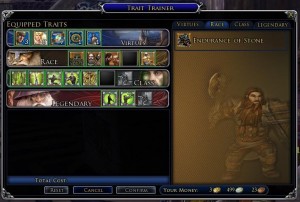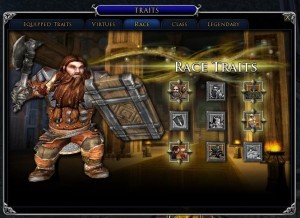This is the fourth article in the series of posts on the Lord of the Rings Trait system (including Virtues and Deeds). This part of the series covers Race based Traits. You can find parts one, two and three under those links.
Introduction
Each of the four races in the Lord of the Rings online game (Men, Hobbits, Elves and Dwarves) have a set of 9 unique Traits. The Traits try and complement the particular mythology or maybe enhance stereotypes of the race in question. In all cases, eight of the Traits come from Deeds related to monster killing and one Trait comes from a purchased item (sold by a reputation vendor in each race’s home city).
Although the Traits are in theory unique, in order to try and balance things out Turbine have ensured the races get similar classes of Trait. For example, each race gets a Trait which affects fellowship manoeuvre’s (FM’s), one which provides a +20 bonus to one character attribute, one which provides a fast travel skill to a starting location, one which provides an increase in damage from certain weapons, etc. As the Traits get harder to earn (higher level creatures), they get more unique.
Gaining Racial Traits
Each Race has a set of three creatures to which they show great enmity. Eight of the Racial Traits are earned by killing creatures in those categories. The types of creatures to be killed highlight one area where earning Racial Traits is not an equally difficult activity for all races. Elves and Dwarves must kill enemies which only come in Signature and Elite varieties for two of their Traits while Men and Hobbits do not suffer this issue. Other than that disparity, the process is the same for all races. For any one creature type there are two or three Deeds required, each opens up at a certain level and requires the previous level to be completed. They are named Enmity of the Creature I, II or III depending on which rank is being worked on.
For example, in the case of Dwarves they can earn Enmity of the Dourhands I at level 13 (when killing any Dourhand will trigger the Deed), but may not start Enmity of the Dourhands II until they are level 19 and have completed Enmity of the Dourhands I.
The ninth Racial Trait is always purchased in the character’s home town, from the reputation vendor. It’s a page that when read, creates a Deed which provides the Trait as a reward, already completed. You need Friend standing with the relevant reputation to purchase the item. This Trait always provides bonuses to 3 Virtues, and importantly, allows an equipped Virtue to rise to rank 11. For example, the Virtuous Man Race Trait provides +1 to Confidence, Justice, and Patience. Equipping that Racial Trait would allow you to take those three Virtues to rank 11 (the normal limit being rank 10), as well as automatically increasing them by 1 rank when equipped.
Equipping / Viewing Racial Traits
Racial Traits are equipped at a Bard like any other Trait (at the cost of around 22 silver each). Each character may have up to 5 Racial Traits equipped from their choice of 9.

The Trait dialog shows you your currently equipped Race Traits, as shown below.

Race Traits – Complete list
The following tables list all the different Race based Traits, and information relating to each of them (such as required level, benefit, and associated Deed).
Race of Man – Traits
| Level |
Deed |
Trait |
Benefit |
| 13 |
Enmity of the Dead I (50) |
Upper-cut |
Short distance Melee attack |
| 13 |
Enmity of the Wargs I (50) |
Man of the Fourth Age |
+20 Will |
| 19 |
Enmity of the Dead II (100) |
Tactics and Might Bonus |
Adds 5% to FM healing and damage |
| 25 |
Enmity of the Dead III (150) |
Man Sword-damage Bonus |
Increases 1H and 2H sword damage |
| 29 |
Enmity of the Wargs II (150) |
Return to Bree |
Fast travel to Bree |
| 30 |
Enmity of the Hillmen I (150) |
Balance of Man |
+1% to Evade, Parry, and Block |
| 35 |
Enmity of the Hillmen II (250) |
Strength of Morale |
Skill which restores ~3000 morale |
| 35 |
Enmity of the Wargs III (150) |
Duty-Bound |
Skill which temporarily increases fellowship member morale |
| 35 |
Friend of Men of Bree |
Virtuous Man |
+1 Confidence, Justice, Patience |
Elves – Traits
| Level |
Deed |
Trait |
Benefit |
| 13 |
Enmity of the Goblins I (50) |
Sylvan Shadows |
Skill which provides Stealth ability |
| 13 |
Enmity of the Orcs I (50) |
Friend of Man |
+20 Fate |
| 19 |
Enmity of the Goblins II (100) |
Tactics and Conviction Bonus |
Adds 5% to FM healing and power |
| 25 |
Enmity of the Goblins III (150) |
Elf Bow-damage Bonus |
Increases bow damage |
| 29 |
Enmity of the Orcs II (150) |
Return to Rivendell |
Fast travel to Rivendell |
| 30 |
Enmity of the Drakes I (150) |
Elf One-handed Sword Damage Bonus |
Increases 1h sword damage |
| 35 |
Enmity of the Drakes II (250) |
Power of the Eldar |
Skill which temporarily increases fellowship member power |
| 35 |
Enmity of the Orcs III (150) |
Eldar’s Grace |
Skill which provides temporary improvement to Parry |
| 35 |
Friend of Elves of Rivendell |
Virtuous Elf |
+1 Wisdom, Patience, Charity |
Dwarves – Traits
| Level |
Deed |
Trait |
Benefit |
| 13 |
Enmity of the Dourhands I (50) |
Head-butt |
Short distance Melee attack |
| 13 |
Enmity of the Goblins I (50) |
Fateful Dwarf |
+20 Fate |
| 19 |
Enmity of the Dourhands II (100) |
Guile and Might Bonus |
Adds 5% to FM damage and DOTs |
| 25 |
Enmity of the Dourhands III (150) |
Dwarf Axe-damage Bonus |
Increases 1H and 2H axe damage |
| 29 |
Enmity of the Goblins II (150) |
Return to Thorin’s Gate |
Fast travel to Thorin’s Gate |
| 30 |
Enmity of the Trolls I (150) |
Dwarf-endurance |
Skill which increases fellowship vitality |
| 35 |
Enmity of the Goblins III (150) |
Endurance of Stone |
Skill which provides mitigation improvements |
| 35 |
Enmity of the Trolls II (250) |
Shield Brawler |
Increases Block chance |
| 35 |
Friend of Thorin’s Hall |
Virtuous Dwarf |
+1 Fidelity, Honesty, Loyalty |
Hobbits – Traits
| Level |
Deed |
Trait |
Benefit |
| 13 |
Enmity of the Spiders I (50) |
Hobbit-stature |
+20 Might |
| 13 |
Enmity of the Wolves I (50) |
Stoop for a Stone |
Ranged attack skill |
| 19 |
Enmity of the Wolves II (100) |
Guile and Conviction Bonus |
Adds 5% to FM healing and DoT’s |
| 25 |
Enmity of the Wolves III (150) |
Hobbit Club-damage Bonus |
Increases 1h and 2h club damage |
| 29 |
Enmity of the Spiders II (150) |
Return to Michel Delving |
Fast travel to Michel Delving |
| 30 |
Enmity of the Goblins I (150) |
Hobbit-Stealth |
Stealth skill |
| 35 |
Enmity of the Goblins II (250) |
Hobbit-Silence |
Feign death skill |
| 35 |
Enmity of the Spiders III (150) |
Hobbit-resilience |
Provides a non-stacking Hope buff for the fellowship |
| 35 |
Friend of Men of The Mathom Society |
Virtuous Hobbit |
+1 Empathy, Honesty, Idealism |
You can see those tables laid out much more nicely over at the lotro-wiki – here.
Summary
Race based Traits allow you to enhance the natural talents of your character as dictated by their race. Some of them are very useful, for example the Hobbit-Silence Trait is invaluable regardless of the class your Hobbit picks, and the huge heal that Men can obtain is a source of jealousy for many other races. The most often sought after skill is the fast travel skill, since any method of reducing journey time in Middle Earth is worth the effort.






